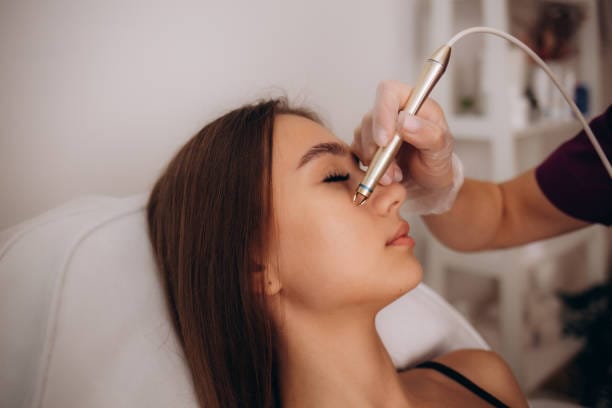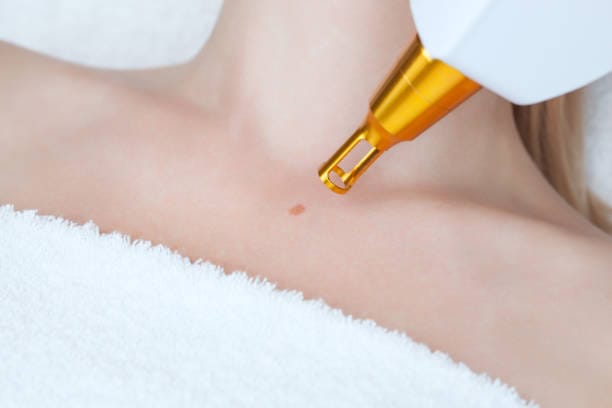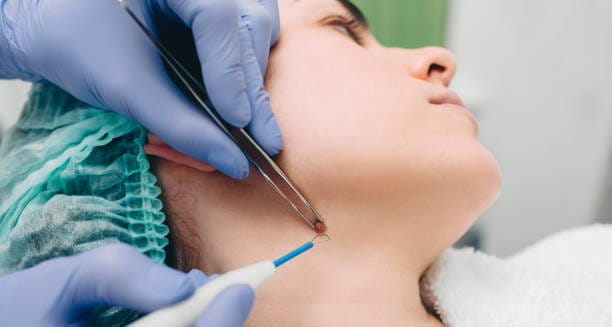Expert Dermatologist Mole Removal for Safe & Effective Results

Most moles are harmless, but they are common get help of Dermatologist Mole Removal. This may cause discomfort or may rarely develop skin cancer. That’s why mole removal is the safest and best action for any inconvenience.
Professional mole removal is like no other home or over-the-counter remedy because it is done safely and hygienically with the least scarring possible. Advanced diagnostic tools are used to examine the moles, and suspicious or harmful moles are identified at the earliest stage. A biopsy can be used to determine whether a mole is cancerous, and in case that’s necessary, a biopsy can help you decide whether to remove a mole.
This article will discuss how dermatologists diagnose suspicious moles, the best mole removal method and what you can expect before and after the treatment. The mole removal process will depend on whether it is done for medical or cosmetic reasons, but knowing how it will happen will make you more comfortable with your decision to remove it.
How Dermatologist Mole Removal Diagnose Suspicious Moles
Moles are not always removed, but some may need to be treated, and the warning signs should be attended to medically. The procedure of mole removal, as advised by the Dermatologist, starts with a thorough diagnosis of whether a mole is benign or potentially cancerous.
1. The ABCDE Rule: Spotting Abnormality By Expert Dermatologist Mole Removal
The ABCDE rule is followed by dermatologists when assessing whether or not a mole needs dermatologist mole removal:
Asymmetry: A – One-half of the mole might not be symmetrical to the other, which may be a warning sign.
Border: An Abnormal mole might have irregular, blurred edges.
Mole – Color: If the mole is colored in brown, black, red, or even blue, it can be a concern.
D—Diameter: Moles larger than 6mm in diameter, roughly the size of a pencil eraser, are more likely to be examined.
E – Evolving: Any size, shape or color changes regardless of time.
Dermatologists investigate if a mole has any of these characteristics and rule out melanoma or other skin conditions.
1. Dermatoscopy: A Closer Look at Mole Structures
A handheld dermatoscope provides strong magnification to reveal microscopic details that medical professionals cannot observe without this instrument. This noninvasive dermatoscopy inspection lets doctors separate trivial moles from potentially risky ones. The doctor will assess pigmentation patterns, examine blood vessels, and perform structural tests to decide if a mole requires additional diagnostic procedures.
2. Skin Biopsy: Testing for Cancerous Moles
Skilled dermatologists perform skin biopsies on possible malignant moles after an initial diagnosis of potential cancer through observation. A laboratory analysis of the mole requires complete or partial surgical sample removal. Multiple biopsy procedures exist, with shave biopsy and punch biopsy among them. The results of a biopsy examination show whether the mole is benign, precancerous or malignant, which directs the appropriate medical treatment.
3. Digital Mole Mapping
The technology of digital mole mapping tracks how moles develop with time using digital image assessment.
Digital mole mapping is an evaluation technique for individuals with numerous moles. This method captures high-definition images of moles and monitors them for months or even years. This diagnostic method makes the early detection of evolving moles feasible for people at increased risk of skin cancer.
When it comes to skin health, people must conduct routine checks as a matter of necessity.
Early detection can save lives. Regular skin examinations should be performed yearly by dermatologists to assess moles, particularly when you exhibit any of the following habits:
- A family history of skin cancer.
- Fair skin or excessive sun exposure history.
- Multiple or large moles.
A dermatologist examination follows immediately when you find abrupt changes in mole appearance. People who receive dermatologist mole removal at appropriate times will stay safe from major medical threats while maintaining a relaxed mind.
Dermatologist Mole Removal: Safe & Effective Procedures
After a dermatologist identifies a mole that requires removal, they select the most appropriate method according to size, depth, and type. If done correctly, dermatologists perform safe and quick mole removal procedures that can result in minimal scarring.

1. Shave Excision: Quick & Scar-Free Removal
This technique works best for minimal non-cancerous moles on the skin's surface.
The dermatologist executes shave excision as a non-invasive, simple procedure during which they perform the following steps:
- The professional applies a local anesthetic to build an anesthetic shield around the treatment zone.
- Experts use a surgical blade to remove or shave the mole at or below the skin level in 'strip' shaving.
- With proper healing at one to two weeks, no stitches are needed.
While this is a minimal scarring method, not all are suitable for deep moles.
2. Surgical Excision: Best for Deep Moles
Indications: Large, deep, or suspicious moles that need to be removed in their entirety.
- The dermatologist numbs the area with local anesthesia.
- Careful excision is made of the mole and a small margin of surrounding skin.
Surgical excision is the most effective method for preventing mole regrowth, but depending on the mole's location, this method can leave a small scar in the mole area.
3. Cryotherapy: Freezing Off Unwanted Moles
Best for: Small, benign moles and skin tags.
Liquid nitrogen is used in cryotherapy, freezing the mole, which then falls off naturally in a few days. This method is fast and not painful; however, multiple sessions will be needed if persistent moles are present.
4. Laser Mole Removal: Ideal for Cosmetic Treatment
Used for: Flat, pigmented moles that don’t need deep removal.
In laser treatment, focused light energy breaks up pigmentation in the mole. Over time, the body absorbs and removes the mole.
- No cuts or stitches are required.
- Relatively little scarring than surgical methods.
- Safe to use on delicate areas such as the face or neck.
Laser mole removal is not good enough for deep or possibly cancerous moles as it does not provide a biopsy sample.
Which Method Is Best By Dermatologist Mole Removal?
This depends on your skin type, mole characteristics, and what you want to achieve cosmetically. They will recommend what will be most efficient about safety and hardly a scar.
What to Expect During the Procedure By Dermatologist Mole Removal
For most dermatologist mole removal treatments, only a little to no downtime is needed, as most treatments are less than 30 minutes long. It may take one to two weeks after surgical excision to remove stitches, and patients can return to daily activities immediately, except for surgical excision
Dermatologist-assisted mole removal is the only safe, precise, and effective way to remove unwanted moles, whether for cosmetic or medical reasons.
What to Expect After Mole Removal
How to analyse the healing process, what aftercare is necessary for a smooth recovery, and minimal scarring after dermatologist mole removal is a given.

Immediate Post-Procedure Care
Immediately after the procedure, the treated area may be tender, red, or slightly swollen. Depending on how it was removed, the dermatologist may give you some care instructions and apply a protective dressing.
- Minimal Comfort: Shave Excision & Laser Removal; healing 1 to 2 weeks.
- Stitches may be required and removed after 7–14 days.
- A scab forms and falls off within a few days to a week.
It usually causes mild pain, which can be taken with over-the-counter pain relievers.
Healing Timeline & Aftercare
Proper aftercare helps facilitate speedy healing and prevent infection or scarring.
- First 24 Hours: Keep the area clean and dry. Keep the site away from touch, such as your hands, scratching, or picking.
- For the first few days, apply antibiotic ointment (if recommended). Do not use makeup or skincare products on the treated area.
- Stitches (if any) are removed, and scabs start to fall off in 1–2 Weeks.
- Any scarring fades, and the skin regenerates after 1–3 Months.
If you want laser mole removal, follow the dermatologist’s skincare instructions to prevent hyperpigmentation or irritation.
Minimising Scarring After Mole Removal
Proper care is essential to best results. Most dermatologist mole removal procedures leave little to no scarring.
- Using sunscreen (SPF 30+) daily can prevent the scar from darkening.
- Use simple, non-irritating products to keep the area moist.
- To speed up the healing process, it is best to avoid smoking and alcohol.
- After the scar has fully healed, massage silicone gel or vitamin E oil to help the skin heal more smoothly.
When to Contact Your Dermatologist
Contact your dermatologist if you notice excessive swelling, pus, or prolonged pain. These symptoms may indicate infection or poor healing.
When treated properly, the healing after dermatologist mole removal is quick and easy. Moles are removed for medical or cosmetic reasons. Regardless, you should care for your skin to ensure a smooth recovery and minimal scarring.
Potential Risks and Complications of Dermatologist Mole Removal
Dermatologist mole removal is generally a safe, everyday procedure, although it is essential to be aware of possible side effects or issues. Many are small and short-lived, but no one knows until one has been through it, so knowing what to expect is the most important thing.
Common Side Effects
Normal post-procedure effects after mole removal include:
- This is also common, especially with surgical or laser mole removal. In most cases, it fades within a few days to a week.
- Skin Heals: The treated area may dry out and form a scab that peels off as the skin heals.
- Tenderness or mild pain are expected, and over-the-counter pain relievers (such as ibuprofen or acetaminophen) can help.
- Skin Discoloration: The treated area may change color, looking darker or lighter, but this usually clears with time.
Possible Complications
However, it is rare, but there may be certain complications that need medical care:
If the area does not improve, you may have an infection. Signs of an infection include increasing redness, warmth, pus, or swelling that lasts over two days. Keeping the area clean and dry can reduce the risk.
The problem includes excessive scarring. Some people develop thickened scars, and others develop keloids (raised scars). This is especially common after surgical mole removal.
Bandages can cause skin irritation or allergic reactions due to contact with their chemicals.
How to Reduce Risks
The following tips will ensure safe healing after mole removal.
- Your dermatologist will instruct you to follow aftercare instructions.
- Don't sit in the sun on that area; apply broad-spectrum sunscreen (SPF 30+) to the treated area.
- Skin with scabs: Do not pick or scratch at them.
- Scar-reducing treatments include silicone gel and vitamin E (only after complete healing).
- Check the site for unusual changes and, if necessary, contact your dermatologist.
When to See a Dermatologist Mole Removal
Suppose this is the case and you find that despite the treatment, you have continuous pain, too much bleeding, excessive reddening or a non-healing wound. In that case, you should visit your dermatologist immediately.
Nothing is risky about dermatologist mole removal, but the risks must be known and precautions taken to ensure a smooth recovery. Aftercare steps can help minimise complications and result in clear, healthy skin.
What to Do After Dermatologist Mole Removal
Aftercare with a dermatologist for mole removal is important for a smooth recovery and less scarring. Taking the right steps will minimise infection risk, promote healing, and keep your canvas clean.
Immediate Post-Procedure Care
Immediately, you will need extra attention after the dermatologist removes the mole.
- Wash the treated skin gently with mild soap and lukewarm water once or twice daily.
- Antibiotic Ointment – If so, apply antibiotic cream, creme or petroleum jelly to keep the wound wet to prevent infection.
- Protect the area with a clean bandage for the first few days, especially if surgical mole removal.
- Don’t Pick at Scabs—It’s a good practice not to pick at or touch the area, as this can cause scarring or infection.
Long-Term Skin Care for Healing
If you follow these after the first healing phase, you should get the best results.
- Apply Broad-Spectrum Sunscreen Daily—To prevent discoloration and scarring, you should apply broad-spectrum sunscreen daily.
- Hydrating With Fragrance-Free Moisturizers – Moisturising the area with scent-free moisturisers will help heal.
- Don’t Use Harsh Skincare Products—Don’t use exfoliants, retinoids, or acids on the treated area until it heals completely.
- Check for Infection Signs—Look for signs of an infection (e.g., redness, swelling, pus) and consult your dermatologist when necessary.
How Long Does It Take to Heal?
Mole removal method heals at different times depending on the method used.
- Laser & Cryotherapy: Heals in 1-2 weeks with minimal scabbing.
- Full healing can take several months, but surgical Excision will require stitches to be removed in 1-2 weeks.
- Scabs may last 7-14 days, and the skin will continue to smooth.
Reducing Scars After Dermatologist Mole Removal
Scar-free skin requires the following extra care tips:
These help soften and flatten scars over time and are Silicone Gel or Silicone Sheets.
Natural remedies like Vitamin E, Aloe Vera, etc.
Don’t Stretch Too Much – If you hold the skin, it won’t look as wide as a scar.
After dermatologist mole removal, you must care for your skin to recover quickly and without a scar. By following these aftercare steps, we can ensure that our skin heals beautifully and smoothly.
Why Choose Revitalise London for Dermatologist Mole Removal?
Through experienced dermatologist mole removal with safe methods and highly effective, we offer mole removal at Revitalise London. All dermatologists in our team are skilled dermatologists who use advanced procedures such as laser removal, cryotherapy, and surgical excision to achieve the correct result. We offer personalised consultations for persons with cosmetic or medically concerning moles to determine the most appropriate treatment for your skin type. We all know nothing is more comfortable than having a satisfying experience during mole removal. Let's agree that most patients want the least downtime possible. Faster healing is the dream goal for every patient, so that's what we aim for! Get professional dermatologist mole removal at Revitalise London. Book an appointment today!
